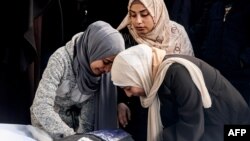U.S. Secretary of State Antony Blinken discussed efforts to free hostages held by Hamas militants in Gaza as he met Thursday with members of Israeli Prime Minister Benjamin Netanyahu’s war Cabinet.
At the start of his meeting with former military chiefs Benny Gantz and Gabi Eisenkot, Blinken said the focus would be on “the hostages and the strong desire that we both have to see them returned to their families, the work that’s being done to that end.”
Blinken said he would also provide updates from meetings he’s had elsewhere in the region on a trip that has included stops in Saudi Arabia, Egypt, Qatar and the West Bank.
Gantz told Blinken that the most urgent issue is finding ways to bring back the hostages.
The meetings come as Israel and Hamas consider a proposal for a new temporary cease-fire that would include a pause in fighting and the release of hostages from Gaza.
A senior Hamas official said a Hamas delegation would travel to Cairo on Thursday to continue negotiations with Egyptian and Qatari officials.
Blinken said Wednesday that the response from Hamas leaders to a plan drafted by U.S., Egyptian, Qatari and Israeli officials contained “clear nonstarters,” but that there was room for ongoing negotiations.
Israeli Prime Minister Benjamin Netanyahu, however, rejected the plan offered by Hamas to end the war in Gaza, instead vowing to push forward with his nation’s attack on the militants until it achieves “absolute victory.”
“We are on the way to an absolute victory. There is no other solution,” Netanyahu said at a news conference after meeting with Blinken. He said Israel’s war effort would take months, not years.
In its proposal, Hamas called for three 45-day phases, first releasing all remaining women and children, as well as older and sick men, in exchange for an unspecified number of Palestinian prisoners held by Israel.
The Hamas plan calls for Israel to withdraw from populated areas and end its aerial bombardment while also allowing far more humanitarian aid to enter Gaza and permitting Palestinians to return to their homes, including in devastated northern Gaza.
The second phase, to be negotiated during the first, would include the release of all remaining hostages, mostly soldiers, in exchange for all Palestinian detainees over the age of 50, including senior militants, to be freed by Israel.
Israel would release an additional 1,500 prisoners, 500 of whom would be specified by Hamas, and complete its withdrawal from Gaza.
In the third phase, the sides would exchange the remains of hostages and prisoners. Israel says it believes more than two dozen of the remaining 130 or so hostages in Gaza have already died or been killed.
The Hamas offer also called for the militants to retain governing control of the narrow territory along the Mediterranean Sea and the right to rebuild its military capability.
Blinken is on his fifth round of talks with Mideast leaders in a so-far fruitless effort to end the warfare that erupted with the October 7 attack on Israel that killed 1,200 people. Hamas health officials in Gaza say Israel’s counteroffensive has killed more than 27,500 and displaced about 2 million Palestinians in Gaza from their homes.
Blinken held talks Wednesday with Palestinian Authority President Mahmoud Abbas in Ramallah and with senior Israeli national security leaders, including Netanyahu and Israeli Defense Minister Yoav Gallant.
Blinken reiterated U.S. support for the establishment of a Palestinian state as the best way to ensure lasting peace and security for Israelis and Palestinians alike, and greater integration for the region. According to the State Department, Blinken also emphasized the urgent need to lower tensions in the West Bank and prevent the conflict from expanding.
Netanyahu has rejected any arrangement that would leave Hamas in full or partial control of Gaza. He also said Israel is the “only power” capable of guaranteeing security in the long term. The U.S. has called for a revitalized Palestinian Authority to govern Gaza and the Israeli-occupied West Bank, which Netanyahu has also rejected.
Martin Griffiths, United Nations undersecretary-general for humanitarian affairs and emergency relief coordinator, said that more than half of Gaza’s population is currently crammed in Rafah, a town originally home to 250,000 people situated right at Egypt’s border.
“Their living conditions are abysmal — they lack the basic necessities to survive, stalked by hunger, disease and death,” said the U.N. humanitarian chief.
VOA U.N. Correspondent Margaret Besheer and White House Bureau Chief Patsy Widakuswara contributed to this report. Some information for this story came from The Associated Press, Agence France-Presse and Reuters.

